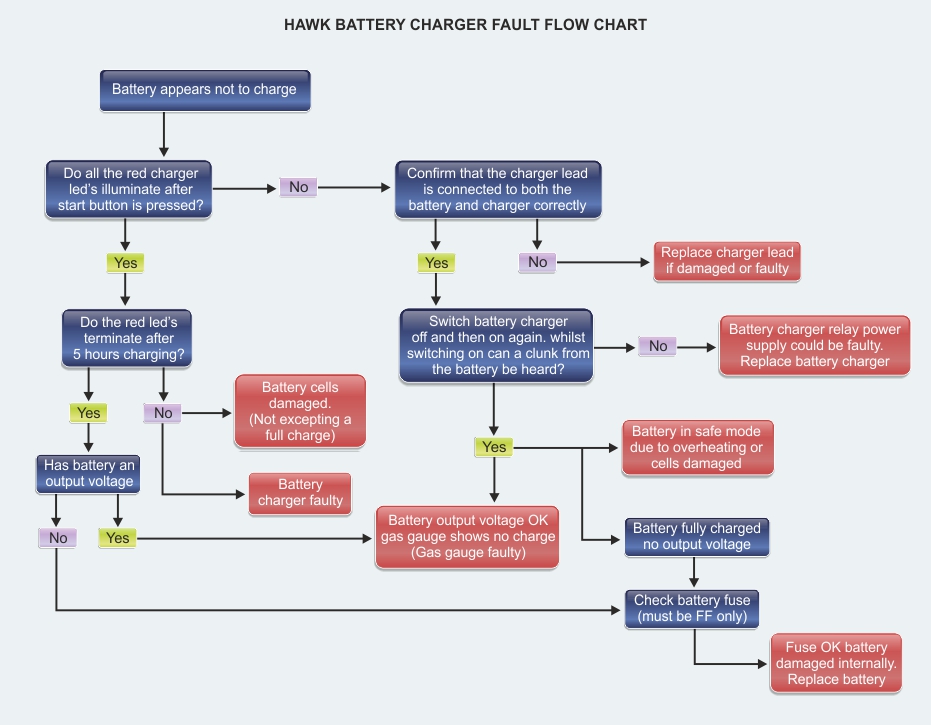Technical Support
Hawk Battery Management Hot Environments 40°C and Above
Impact on the HAWK battery in hot climates
All batteries suffer when exposed to extreme heat, dependent on their chemistry some worse than others: to the point of permanent irretrievable damage. Fortunately, the Ni-MH battery chemistry within the HAWK battery can take more punishment than many forms of other chemistries found in batteries today. In saying this, it does not mean that Ni-MH batteries are excluded from this problem.
All batteries self discharge and the rate of self discharge is dependent on temperature. The higher the temperature, the more the rate of self discharge will increase. Depending on their chemistry some batteries will self discharge faster than others.
A Ni-MH battery (HAWK) has a self discharge rate of approximately 0.3% per day at a room temperature of 20°C: If increased, to 35°C will self discharge at a rate of 1% per day. Increase this to 50°C and the self discharge rate rises to 5% per day.
If we take the 50°C temperature rate against self discharge, you will find that a 50Ah HAWK battery will lose 2.5 amps per day even though it is not being used. In round terms this means that the battery will be flat in 20 days. (Although, in true terms the self discharge rate is logarithmic and would be around 35 days.)
Once the HAWK battery is allowed to go below its threshold voltage of 19 volts, (no output from the battery), and continue in a downwards trend to zero volts, its re-charge battery efficiency will be greatly reduced, which could be as much as 50% of its output capability i.e. 25Ah instead of 50Ah.
Unlike an SLA product, the chemicals within the Ni-MH system are dissimilar. This means they cannot shed material or passivate.
The HAWK battery can be brought back up to voltage by charging very slowly at C/20 then slowly discharging to about 75% capacity. Then charge again with a slightly higher rate of charge. If this method is required to bring the battery back on line it is recommended that it be returned to A.T.S.I. in order to complete this successfully.
To maximize current output and reduce the risk of permanent damage to the HAWK battery in extreme temperatures it is vital to follow the procedures recommended by the manufacturer.
Hawk Electronic 24volt Battery
Trouble Shooting
Battery management is even more crucial in high ambient temperatures.
To minimise battery problems in these conditions there is one simple rule.
KEEP IT AS COOL AS POSSIBLE
This will greatly reduce self-discharge and improve the charging characteristics.
| Problem | Possible Cause | Possible Remedy |
| No output from battery | Fuse not locked in holder | Check fuse is located correctly *(1) |
| Fuse blown | Replace 12.5Amp FF Fuse | |
| Battery over-heated | Allow battery to cool for 1 hour *(2) | |
| Fuse keeps blowing | Incorrect fuse fitted | Replace with 12.5Amp FF Fuse |
| Short on output lead | Replace output lead *(3) | |
| Equipment pulls over 12.5 amps | Use two batteries in parallel *(4) |
|
| Equipment faulty | Check equipment *(5) | |
| Gas gauge shows red LED flashing only after full charge has been completed | Battery over-heated, causing gas gauge to re-set to zero |
Allow battery to cool, after which proceed with full discharge then recharge again *(6) |
| Gas gauge shows 3 or less LEOs after full charge | Gas gauge out of sync with battery | Discharge battery fully, then recharge fully *(7) |
| Gas gauge showed all 4 LEOs after full charge, then after short time, reverted to red flashing only. |
Battery over-heated, causing gas gauge to re-set to zero |
Allow battery to cool, after which proceed with full discharge, then recharge again *(8) |
*Note
*(1) The fuse is fitted within a cartridge holder. Use a coin to twist slotted outer
fuse holder anti-clockwise to pull cartridge out.
To replace fuse remove old fuse by pulling out of cartridge and replace
with new 12.5 amp FF. Slide cartridge back into housing and turn clockwise.
*(2) In high ambient temperatures it is possible that the battery could over-heat
This will automatically disengage the battery thermal resettable fuse.
Once the temperature has cooled sufficiently inside the battery the fuse
will re-set.
If this does take place the gas gauge will trip out and re-set to zero.
Once the battery thermal fuse has re-set, (although the gas gauge is
showing a red flashing LED), the battery can still be used as it will be fully
charged.
If the battery charger is showing a fully charged battery, the battery
will be fully charged irrespective of the gas gauge.
*(3) Should the output lead be accidentally damaged causing the positive
and negative, leads to short out this will blow the fuse in the battery.
The "HAWK" is protected against this occurrence happening. Once
the fuse and lead has been replaced, the "HAWK" will function normally
without any damage having been done to the battery.
Remember that if this has occurred, the gas gauge will have re-set to zero
and will only correct itself on the next charge cycle.
*(4) Should the equipment being used require more than 12.5 amps current draw, the only way to resolve this issue is to connect two "HAWK" batteries through a two in one Y lead or parallel junction box, (not the RMPARBU/24-6 unit) this will increase battery output to 25Ah.
*(5) Equipment that the battery is connected to could have developed a
fault causing current draw to rise significantly.
It must be understood that a battery cannot damage or cause a fuse
to blow, (unlike a power supply), within the equipment, provided the
equipment is rated for that power source,(i.e. voltage is correct)
A battery's maximum voltage capability cannot rise, it can only descend
A mains power supply could damage equipment should the power supply
become faulty or be set incorrectly.
*(6) The gas gauge is autonomous to the battery and as such is only a
reference device.
The "HAWK" battery will function normally with or without the gas gauge
operating correctly.
If the gas gauge chip temperature reaches 70°C or above it will shut down
and re-set itself to zero, irrespective of the state of charge of the battery.
Provided the battery charger has charged the "HAWK" battery fully
(indicated by the red flashing LED on the charger), the battery can be
deployed in the normal fashion.
*(7) Should the "HAWK" battery be left in storage for a long period of time, or
be subject to extremes of heat, it is possible for the gas gauge to go out
of synchronization giving the operator false readings.
This will not effect the operation of the battery and will re-calibrate itself
once the battery has gone through a full discharge/charge cycle.
*(8) The gas gauge is autonomous to the battery and as such is only a
reference device.
The "HAWK" battery will function normally with or without the gas gauge
operating correctly.
If the gas gauge chip temperature reaches 70°'C or above it will shut down
and re-set itself to zero, irrespective of the state of charge of the battery.
Provided the battery charger has charged the "HAWK" battery fully
(indicated by the red flashing LED on the charger), the battery can be
deployed in the normal fashion.

Further reading:
